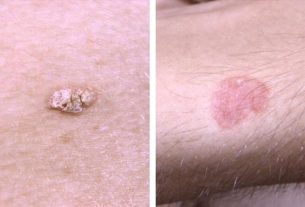Gallbladder cancer is a type of malignant tumor that originates in the cells of the gallbladder, which is a small organ of the digestive system responsible for storing bile, a substance produced by the liver and which participates in the process of digesting fats from food. .
This type of cancer is rare and, in the early stages, does not cause any type of symptoms and, therefore, in many cases, it is diagnosed in more advanced stages, when it has already affected other organs such as the liver, causing symptoms such as pain or swelling in the belly, or yellowed skin and eyes, for example.
The treatment of gallbladder cancer must be indicated by an oncologist and involves surgery to remove the gallbladder, chemotherapy or radiotherapy, to eliminate tumor cells and prevent their spread to other organs.

Main symptoms
The main symptoms of gallbladder cancer are:
- Persistent right-sided abdominal pain;
- Belly swelling;
- Frequent nausea and vomiting;
- Yellow skin and eyes;
- Decreased appetite;
- Weight loss;
- Persistent fever above 38ºC;
- Chills.
Symptoms of gallbladder cancer usually appear in more advanced stages of the disease and, therefore, if signs and symptoms indicative of this type of cancer appear, it is important to consult a gastroenterologist or general practitioner so that it is possible to confirm the diagnosis and begin treatment. treatment as quickly as possible.
How to confirm the diagnosis
The diagnosis of gallbladder cancer is normally made by a gastroenterologist who uses some imaging tests, such as abdominal ultrasound, computed tomography or magnetic resonance imaging to identify the development of cancer in the gallbladder.
Make an appointment with a gastroenterologist in the nearest region:
Taking care of your health has never been easier!
In addition, the doctor must also order blood tests to identify the tumor markers, CA 19-9 and CA-125, which are substances produced by the body in cases of gallbladder cancer.
Once the diagnosis of gallbladder cancer is confirmed, the gastroenterologist must refer the person to undergo treatment with an oncologist.
Possible causes
The exact cause of gallbladder cancer is unknown, but some factors may contribute to its appearance, such as:
- Age over 75 years;
- Gallstones;
- Polyps in the vesicle;
- Gallbladder infection;
- Chronic inflammation of the gallbladder;
- Diabetes;
- Abnormal bile ducts.
Furthermore, gallbladder cancer is more common in women, in people who suffer from obesity or who have a family history of this type of cancer.
How the treatment is carried out
Gallbladder cancer treatment must be guided by an oncologist and usually includes:
1. Surgery
Surgery for gallbladder cancer is the main type of treatment used and is generally done to remove as much of the tumor as possible, and can be done in 2 ways:
- Cholecystectomy: done for complete removal of the gallbladder when the cancer has not spread beyond the gallbladder and its ducts. See how cholecystectomy is performed;
- Partial hepatectomy: used when the cancer is close to the liver, and it is recommended to remove, in addition to the gallbladder, a small portion of the liver;
In some cases, when gallbladder cancer is small, in its early stages and the doctor is able to completely remove it through cholecystectomy, further treatment may not be necessary.
However, when surgery is not able to completely eliminate the tumor in the gallbladder or it is at a more advanced stage, the doctor may also recommend radiotherapy or chemotherapy to try to eliminate the remaining cancer cells.
2. Chemotherapy
Chemotherapy for gallbladder cancer can be given before surgery, to reduce the number of cancer cells and facilitate tumor removal, or after surgery, to eliminate remaining tumor cells.
This type of treatment can be done by injecting medicine directly into the vein, such as cisplatin, fluorouracil or gemcitabine, or, in some cases, it can also be done by taking pills, such as capecitabine, for example.
Chemotherapy works by preventing cancer cells from dividing and multiplying, but it also acts on all normal dividing cells in the body, such as hair follicle or blood cells, which can cause side effects such as hair loss or a decrease in the defense system. body, increasing the risk of infections, for example. Learn how to alleviate the side effects of chemotherapy.
3. Radiotherapy
Radiotherapy for gallbladder cancer is normally used in more advanced cases of the disease, in which it is not possible to remove the tumor with surgery, to alleviate symptoms such as pain, persistent nausea and loss of appetite, for example, and often can be done in combination with chemotherapy.
This treatment is carried out using a machine, placed near the affected area, which emits radiation capable of destroying tumor cells, requiring several sessions of radiotherapy, which can cause side effects such as itching, irritation or burns to the skin. Check out what to do to alleviate the side effects of radiotherapy.
Staging of gallbladder cancer
The staging of gallbladder cancer is done through a biopsy of a sample of the gallbladder taken during surgery and the results may include:
- Stadium I: the cancer is limited to the inner layers of the gallbladder;
- Stage II: the tumor affects all layers of the gallbladder and can develop into the bile ducts;
- Stage III: cancer affects the gallbladder and one or more neighboring organs, such as the liver, small intestine, or stomach;
- Stage IV: development of large tumors in the gallbladder and in various organs in more distant locations in the body.
The more advanced the stage of development of gallbladder cancer, the more complicated the treatment, making it more difficult to achieve a complete cure for the problem.
Is gallbladder cancer curable?
Gallbladder cancer is curable when diagnosed at an early stage and treatment is started early. However, in more advanced stages, when the cancer has already spread to other organs, it is more difficult to achieve a cure and, in these cases, only palliative care may be indicated by the oncologist to keep the person comfortable and pain-free.

Sign up for our newsletter and stay up to date with exclusive news
that can transform your routine!
Warning: Undefined array key "title" in /home/storelat/public_html/wp-content/plugins/link-whisper-premium/templates/frontend/related-posts.php on line 12
Warning: Undefined array key "title_tag" in /home/storelat/public_html/wp-content/plugins/link-whisper-premium/templates/frontend/related-posts.php on line 13



